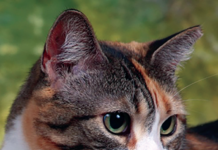Cool climate? Cool house? The climate in which a cat with a pointed-coat pattern (such as a Siamese, Himalayan, Colorpoint Shorthair, or Balinese, which have pale colored hair on the body and darker hair on the points) is born, as well as the ambient temperature of the home in which the cat lives, will cause the coat color to vary. More than genetics plays a role in the coat color. So, a Siamese cat living in Jamaica will most likely be lighter in color than one living in Minnesota. A Himalayan living in a cool house will be darker than one whose human companion keeps the thermostat set at 78 degrees.
Genetic and chemical factors
The Siamese pattern (cs) is caused by an allele that is part of the albino series. On the one end of the spectrum is the dominant member of the group (C), which causes full color to develop. At the other extreme is the pink-eyed albino gene (c).
The allele works the same in all pointed cats, whatever the breed, says Elizabeth Oltenacu, PhD, associate professor of animal science at Cornell University, and it is the same as the Himalayan pattern, which is the name used in other species like mice and rabbits.
Kittens with the Siamese gene are born white or light because their first coat grows in a warm environment – their mothers womb. As the kittens reach about 6 weeks of age, their coat, including the points, begins to darken. By the time they grow their next coat, they are out and about, says Oltenacu, so ambient temperature is much cooler and the points develop.
Darker hair develops on the points because they are farthest away from the body core where temperature is maintained at a steady level and they (the points) lose heat faster, thus becoming cooler. Point colors for various breeds may include seal (black with a sepia-brown appearance), blue (gray appearance), lilac (frost), chocolate (brown), flame (red), cream, or tortie. Not all colors are recognized by all cat registries for given breeds, however. A point-patterned cats body hair stays pale on the warmer parts of the body. If the hairs are long, youll find that even the dark ones have light bases, says Oltenacu.
A biochemical pro-cess produces melanins in cats. Enzymes act as catalysts, and one of these enzymes, tyrosinase, is essential for pigment formation. The true albino allele in this series shuts pigment formation down completely, but the Siamese allele makes tyrosinase sensitive to ambient temperature, says Oltenacu.
The tyrosinase is still present in every cell of a Siamese cat, but local temperature when the hair is actively growing determines if it can function or not.
Because tyrosinase is still present in every cell, hair everywhere on the body has the potential to be the same color as the points. If you shave your Himalayan cat because of knots, for example, and the temperature of the house during regrowth is cool, the hair on the body will be quite dark. Similarly, you can make hair on the points regrow white if the area is kept warm enough during regrowth, says Oltenacu.
A breeder can influence the intensity of a Siamese cats coat color by manipulating ambient temperature, according to Oltenacu. Cool housing will result in darker color than will warm housing. And, yes, time of year can have the same impact as long as the cat is not in a temperature controlled environment, says Oltenacu.
Cats with point-pattern coats darken with age, possibly because of decreased circulation or reduced grooming (remember, evaporating saliva has a cooling effect). No one is sure why.



